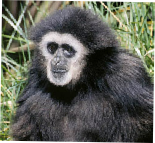

Unlike most other primates gibbons are monogamous (mating for life) and live in single family groups. A Gibbon family unit will occupy a territory and defend its boundaries by a vigorous vocal and visual display. Mated Gibbons sing to each other in spectacular, almost bird-like duets, and occasionally the young will join in.
Gibbons are some of the world's greatest trapeze artists. They have the ability to swing and leap distances of 50 feet from tree to tree at speeds of up to 35 mph and the fact that they may be 200 feet above the ground does not seem to concern them.
The number of surviving gibbon species is generally put at between thirteen and fifteen, depending on how the sub-species are classified. Their colourations range from cream to brown, and grey to black. In some species the males and females have a sex-specific colouration, whilst the colours of infants in some species are different from the adults. They can be divided into four groups in terms of their physical characteristics.These are Crested Gibbons, Siamangs,hHoolock Gibbons and Agile Gibbonsis mode of locomotion i.e. swinging beneath branches, while suspended by their hands, is called brachiating. (The spider monkeys of South America also move about in this way, but unlike Gibbons they have prehensile tails which they use as an extra limb)
Gibbons.. are small tree living apes native to the rainforests of Southeast Asia. They are an endangered species, threatened by a habitat loss of thousands of acres per day and a flourishing illegal wildlife trade.
Crested Gibbons
Tonkin Black Crested
Laotian Black Crested
Eastern Black Crested
Hainan
Northern White Cheeked
Southern White Cheeked
Buff Cheeked
Found in...
North Vietnam
Northwest Laos
N E Vietnam, Southern China
Hainan Island (China)
North Vietnam & Laos
Central Vietnam & South Laos
S Vietnam, S Laos, E Cambodia
Siamangs
Sumatran Siamang
Malaysian Siamang
Found in...
Sumatra
Malaysia
Hoolock or White-Brown Gibbon
Western Hoolock
Eastern Hoolock
Found in...
Northeast India & Bangladesh
Southwest Yunnan & N.E. India
Agile Gibbons
Lowland Agile Gibbon
Bearded Gibbon
Kloss Gibbon
White Handed Lar Gibbon
Moloch, Silvery, or Javan Gibbon
Muellers, Bornean, or Grey Gibbon
Abbotts Grey Gibbon
Northern Muellers Gibbon
Pilleated, or Capped Gibbon
Found In...
East Sumatra & North Malaysia
Southwest Borneo
Mentawai Islands
Myanmar, Thailand, Yunnan, Malaysia & Sumatra
Java
Southeast Borneo
West Borneo
North Borneo
Southeast Thailand, West Cambodia & Laos



Gibbons are “Old World Apes”. They have no tail and are found across Asia. Their New World, South American Contempories, such as Spider Monkeys have long prehensile tails which they can use to grip branches and for balance.
This is Oliver
Yoko
The largest gibbons are the Siamangs which are also the World’s loudest land mammals. Our gibbons are all White Handed Lar Gibbons and they are also quite vocal. Their singing carries long distances and this is how they are able to communicate in dense tropical forests in the wild.
